 Review of Lines and Slopes of Lines
Review of Lines and Slopes of Lines
For success in Precalculus and Calculus, you must have an extremely high comfort level working with lines and slopes of lines. This lesson offers an in-a-nutshell review of essential concepts. It might be all that you need!
For a thorough review, however, go through the following lessons in order. Be sure to click-click-click the exercises in each section to check your understanding.
- ‘Slope’ is a number that measures the ‘steepness’ of a line; it is conventionally denoted by the variable $\,m\,.$
- Let $\,(x_1,y_1)\,$ and $\,(x_2,y_2)\,$ be two points on a non-vertical line. Then: $$ \cssId{s12}{m = \text{slope}} \cssId{s13}{= \frac{\text{rise}}{\text{run}}} \cssId{s14}{= \frac{y_2-y_1}{x_2-x_1}}$$
-
‘Rise’ denotes
vertical travel:
- up is positive
- down is negative
-
‘Run’ denotes horizontal
travel:
- to the right is positive
- to the left is negative
-
To find the slope of any
non-vertical line:
- Choose any two points.
- Travel from one to the other, going vertically first (the rise) and horizontally second (the run).
- Take the rise, and divide by the run.
- Horizontal lines have slope zero ($m = 0$).
- Vertical lines have no slope (the slope does not exist, due to division by zero).
- Two nonvertical lines are parallel if and only if they have the same slope.
- Perpendicular lines have slopes that are opposite reciprocals. For example, lines with slopes $\,3\,$ and $\,-\frac 13\,$ are perpendicular.
-
Going from left to right:
- Uphill lines have positive slopes.
- Downhill lines have negative slopes.
- Steep lines have big slopes (numbers far away from zero).
- Gradual lines have small slopes (numbers close to zero).
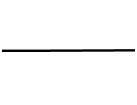 Horizontal line,
Horizontal line,zero slope,
equation $\,y = k\,$
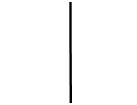 Vertical line,
Vertical line,no slope,
equation $\,x = k\,$
Uphill Lines, Positive Slopes
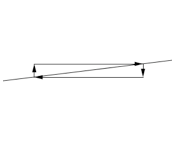 Gradual uphill,
Gradual uphill,small positive slope
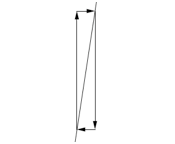 Steep uphill,
Steep uphill,large positive slope
Downhill Lines, Negative Slopes
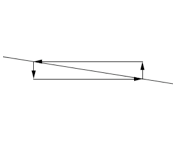 Gradual downhill,
Gradual downhill,small negative slope
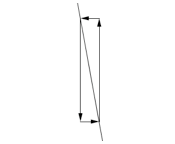 Steep downhill,
Steep downhill,large negative slope
-
Standard form, $\,ax + by + c = 0$
- As long as $\,a\,$ and $\,b\,$ are not both zero, then $\,ax + by + c = 0\,$ graphs as a line.
- When $\,a = 0\,$ there is no $\,x\,$ term, and the line is horizontal. Horizontal lines can be written in the form $\,y = k\,.$
- When $\,b = 0\,$ there is no $\,y\,$ term, and the line is vertical. Vertical lines can be written in the form $\,x = k\,.$
-
Slope-intercept form, $\,y = mx + b$
- Every equation of the form $\,y=mx+b\,$ graphs as a non-vertical line.
- The slope of the line is $\,m\,$ (the coefficient of the $\,x\,$ term).
- The line crosses the $y$-axis at the point $\,(0,b)\,.$
-
Point-slope form, $\,y - y_1 = m(x - x_1)$
- This line has slope $\,m\,$ and passes through the point $\,(x_1,y_1)\,.$
-
Intercepts:
- To find an $x$-intercept: set $\,y = 0\,$ and solve for $\,x\,.$
- To find a $y$-intercept: set $\,x = 0\,$ and solve for $\,y\,.$
-
For lines, equal changes in the input give rise to equal changes in the output. If $\,x\,$ changes by $\,\Delta x\,$ (delta $\,x\,$), then $\,y\,$ changes by $\,m\Delta x\,.$
That is, the outputs change $\,m\,$ times as fast as the inputs (where $\,m = \text{slope}\,$).
Example: If a line has slope $\,3\,,$ the outputs change $\,3\,$ times as fast as the inputs.